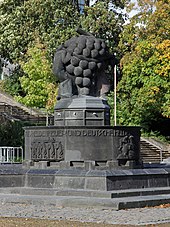Wine fountain (Koblenz)


The wine fountain , also known as the grape bearer fountain , is a fountain in the Rhine complex in Koblenz . The wine fountain, created in 1928, was originally set up in front of the Rheinhalle on the former site of the 1925 "Reichsausstellung Deutscher Wein" event. Removed when the rubble was cleared after the Second World War , the grape-bearer sculpture found a new home in the fountain in the wine village . On the initiative of the Rheinanlagen eV association, the complete wine fountain was rebuilt in 2013 on a meadow in front of the wine village.
history
On the occasion of the “Reich Exhibition of German Wine” in 1925 , the memorial of German wine created by Professor Josef Henselmann was erected in the courtyard of the Rheinhalle in the middle of the event site. Due to the nudity of the characters depicted, however, it caused violent protests among the population. It was eventually veiled and completely removed in 1928. In World War II it was then destroyed. As a replacement for the memorial, the wine fountain was commissioned from Carl Burger in 1928 and set up in the same place.
In air raids during World War II, the former event site of the “Reichsausstellung Deutscher Wein” was completely destroyed in 1944. Because of its extremely high popularity, some buildings on the Rhine, today's wine village Koblenz , were rebuilt in a somewhat simplified form in 1951 . The fountain, which was still completely preserved after the Second World War, later had to give way to the new construction of the Rhein-Mosel-Halle (1959–1962) when the site was cleared. Then the remains of the sculpture were placed in front of the wine village, the fountain itself was dismantled and stored in a building yard in Niederberg . Layer citizens wanted to set up the fountain in their district in 1975, but at that time it could no longer be found.
The Förderverein Rheinanlagen eV has been re-erecting the complete wine fountain since 2004. For this purpose, the missing parts of the well were searched for, rediscovered at the building yard in Niederberg and then given to a restorer. In autumn 2013 the wine fountain could be rebuilt on a meadow south of the wine village, the inauguration took place on October 6, 2013. The cost of the re-erection was financed by donations. The wine fountain has not yet been connected to the water supply because the necessary funds are lacking. However, this should also be implemented in the near future.
construction
The expressionist wine fountain was made from basalt lava . It shows both biblical and historical motifs. The head of the fountain consists of a sculpture of grape carriers ( 4 Mos 13.23 EU ). The fountain trough has four reliefs from the heroic epic of the Nibelungen saga. In addition, the following toast is appropriate to Siegfried , which comes from the poem “Rheinsage” by Emanuel Geibel : “But we fill the Romans and drink German hero fire and German hero power in the golden juice. " According to Herbert Dellwing and Udo Liessem ," the sculpture [...] is to be understood as a reference to the expected liberation from the French occupation and thus to be interpreted politically ".
The trough stands in a star-shaped pool of water. The following text is carved on a corner stone of the basin: “ Gestiftet vd Industrie und d. City of Mayen, designed a. modeled v. Carl Burger, carried out by the Steinmetzfachschule “. The wine fountain is 3.9 m high and has an outer diameter of 8.5 m, the mean diameter is 3.0 m.
See also
literature
- Herbert Dellwing (editor): Cultural monuments in Rhineland-Palatinate. Monument topography Federal Republic of Germany. Volume 3.1: City of Koblenz. Southern suburb and Oberwerth. Schwann, Düsseldorf 1986, pp. 68f. ISBN 3-590-31033-2 .
- Udo Liessem: Fifty Years of Koblenz City History. 1890-1940. Görres-Verlag, Koblenz 1983, p. 43 and illustration p. 91. ISBN 3-920388-01-1 .
Web links
- Project page for the reconstruction of the wine fountain
- Reich Exhibition of German Wine 1925 in: weissergasse-koblenz.de
Individual evidence
- ↑ See the illustrations in: Peter Brommer, Peter Kleber, Achim Krümmel: Koblenz in the flashback. Photographic excursion through the years 1862 to 1945. Görres, Koblenz 2004, ISBN 3-935690-34-7 , pp. 73 and 76.
- ↑ Ur-Schängel advocate re-establishment. ( Memento from March 4, 2016 in the Internet Archive ) (PDF; 11.8 MB) In: Super Sonntag. May 8, 2011.
- ↑ The historic wine fountain is set up! ( Memento from October 20, 2014 in the Internet Archive ) on the website of the Förderverein-Rheinanlagen eV
- ↑ The fountain monument is set up in front of the Koblenz wine village. in: Rhein-Zeitung , August 21, 2013.
- ↑ Koblenzer Weinbrunnen has returned in: Rhein-Zeitung , October 7, 2013
- ^ "Rheinsage" from Emanuel Geibel's youth poems
- ↑ H. Dellwing, U. Liessem, p. 68. The Koblenz zone was to be cleared in 1929.
Coordinates: 50 ° 21 '9.8 " N , 7 ° 36' 5.2" E



